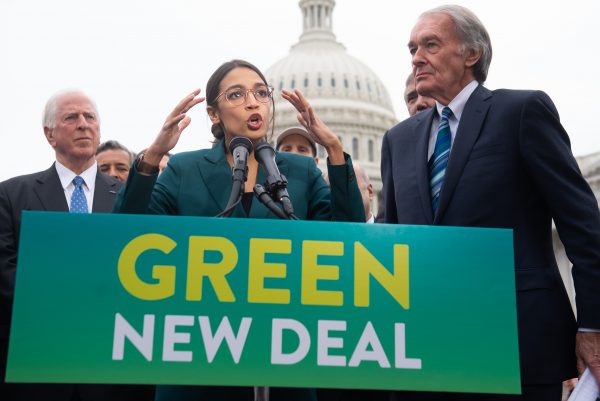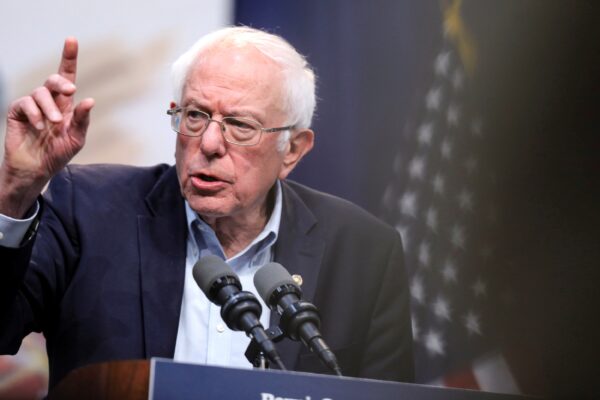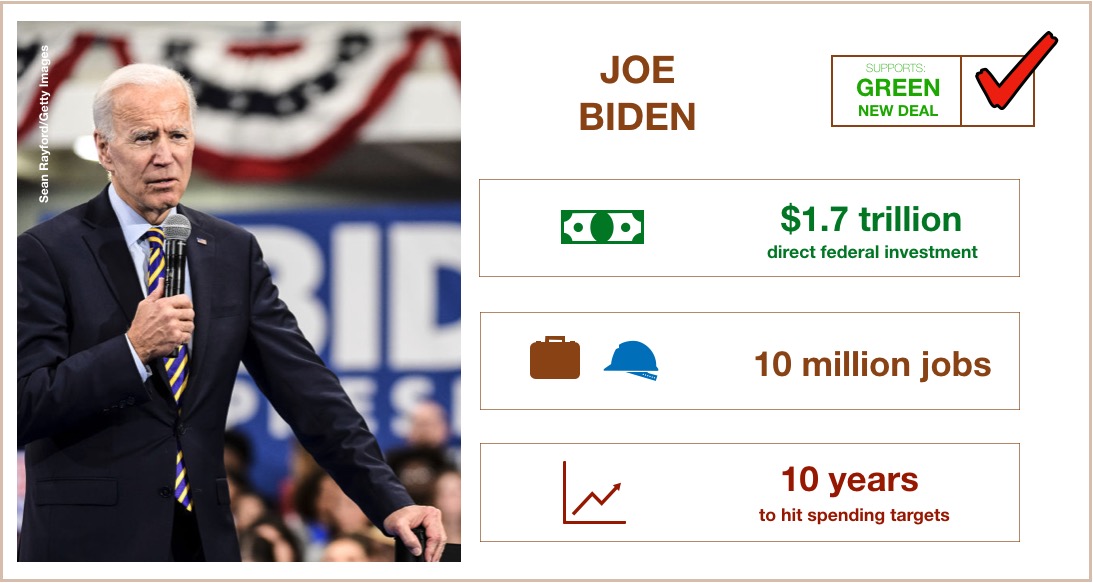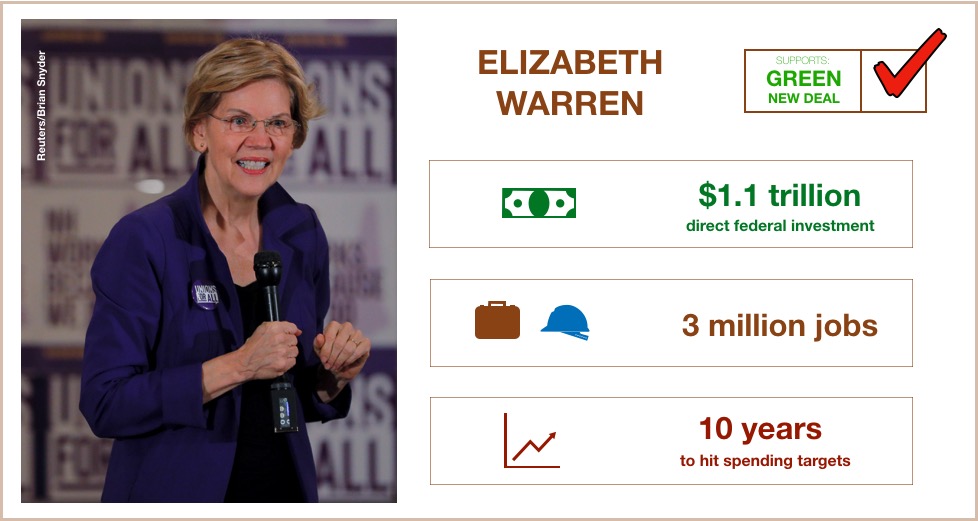The field of Democrats vying to win their partys nomination for a chance to oust President Donald Trump in 2020 is the biggest and most diverse in history. What unites them is an allegiance—to varying degrees—to a controversial policy framework that seeks to reforge Americas economy in line with the vision of a “clean energy” future.
A successful Democratic challenge to Trump would likely see a figure in the Oval Office whose policies are based on—or in sympathy with—the expensive and expansive Green New Deal (GND). It is both a concept for a radically new “clean energy economy” and the engine that is supposed to drive growth and jobs.
The GND resolution calls for “a new national, social, industrial, and economic mobilization on a scale not seen since World War II and the New Deal.” Seeking to spurn carbon dioxide-producing fossil fuels while spurring carbon-free sources of energy, the GND charts a set of goals and guiding principles for the candidates to then flesh out with specific policy proposals. Most of the Democratic 2020 contenders have expressed support for the GND, including the entire leaderboard.


Economically, the trillions of dollars the GND is projected to cost is also envisaged as the stimulus that will contribute to GDP and jobs. Employment-related promises by the GND-inspired Democratic candidates range from Tom Steyers 46 million job-years (4.6 million jobs held for 10 years), to Bernie Sanders 20 million, Joe Bidens 10 million, Pete Buttigiegs 3 million, and Elizabeth Warrens 1 million jobs.
Economically, Scientifically, and Numerically Illiterate Program
Critics of the GND, including Trump and the Republicans, denounce the scheme as costly, radical, and socialist.
Stanford Professor Michael Boskin has called “the $10 trillion Green New Deal, an economically, scientifically, and numerically illiterate program.” The American Action Forum, led by former Director of the Congressional Budget Office Douglas Holtz-Eakin, estimated the plan could cost between $51–$93 trillion over the next decade.
“This is a nonsensical plan that basically gives away trillions of dollars,” said Daniel Turner, Founder and Executive Director of Power the Future, in a conversation with The Epoch Times. “Bernie wants to do this to the tune of $16 trillion dollars. This is totally devoid of math, its devoid of physics, its devoid of economics.”
Sanders claims his $16.3 trillion GND-inspired plan will “pay for itself over 15 years” by raising taxes and fees on fossil fuel companies, through revenue generated by renewable energy produced by federal power authorities, over $1 trillion in reduced military spending, and from income tax collected from the 20 million new jobs he says his plan will create.


“He wants to give $2 trillion to American consumers to buy electric vehicles,” Turner said, adding, “$2 trillion is half our federal budget right now. Where is this $2 trillion coming from? Look at the amount of tens of millions of dollars that the fossil fuel industry pumps into our economy through tax revenue. We eliminate that but were supposed to have the same amount of revenue in the Treasury? Thats nonsense.”
In his plan, Sanders has proposed bolder energy-related goals and on a tighter timeline than the net-zero emissions by 2050 called for in the GND resolution.
“Reaching 100 percent renewable energy for electricity and transportation by no later than 2030 and complete decarbonization of the economy by 2050 at the latest,” Sanders says on his campaign page.
“When he says we are going to be carbon-free by 2030, were going to produce all of our electricity and all of our transportation without fossil fuels, thats just a myth,” Turner said. “Thats just not physically, technologically possible to do that right now.” Turner argues that a top-down state-driven push to reject fossil fuels and adopt green energy would cause massive job losses and spikes in prices of food and electricity, hitting Americas poorest the hardest. Besides, Turner adds, a GND-inspired transition is only possible under circumstances of greater government control and reduced civil liberties.
“The Green New Deal is not about the environment and its not about climate change.” Turner argues. “Its a socialist manifesto. This is a way to restructure America.”
Saikat Chakrabarti, former chief of staff to Rep. Alexandria Ocasio-Cortez and author of the GND, appeared to admit as much. “The interesting thing about the Green New Deal is it wasnt originally a climate thing at all,” Chakrabarti said. “We really think of it as a how-do-you-change-the-entire-economy thing.”
Geologist Gregory Wrightstone, author of “Inconvenient Facts: The Science That Al Gore Doesnt Want You to Know,” told The Epoch Times that a radical shift away from fossil fuels into unproven and unreliable sources of energy would cause not just economic contraction, but more human misery.
“Were being told: No, dont use our resources to better mankind. You need to quit using fossil fuels that are actually lifting people out of generational poverty,'” Wrightstone said. “There are an estimated 4 billion people around the earth who are living in energy poverty. There are 4 million deaths a year from lung disease from people cooking in their homes with wood, a lot of it dried dung. They could benefit from more electrification, propane, compressed natural gas, so they dont have to die an early death.”
“What these people are doing who are pushing the Green New Deal and the Paris Climate Accord, theyre destining billions of people around the world to continued generational poverty,” Wrightstone said. “Weve been lifting people out of poverty using fossil fuels by providing abundant, affordable, reliable energy and not one of those three words are associated with wind or solar.”
Destroyer of Societies
In the economic arena, Trump believes his fight in next years election is to counter a risky socialist experiment that would throw his roaring Trumponomics-fueled economy into a tailspin. More fundamentally, Trump views the election as a battle for the soul of the nation.
“Here, in the United States, we are alarmed by new calls to adopt socialism in our country. … Tonight, we renew our resolve that America will never be a socialist country,” he said during the State of the Union address. Later, during an address at the United Nations, Trump called socialism a “destroyer of societies.”
“One of the most serious challenges our countries face is the specter of socialism,” Trump said. “Its the wrecker of nations and the destroyer of societies.”
Trumps economic policies have been forged in the spirit of Reaganomics—market-led not government-driven and based on tax cuts, deregulation, and an embrace of fossil fuel production.
Lawrence Kudlow, former financial analyst and current head of the National Economic Council under Trump, characterized the presidents position on the economy in the foreword to the book “Trumponomics,” writing that, “Trump says we can get to 3, 4, or even 5 percent growth through tax reduction, deregulation, American energy production, and fairer trade deals, and he is exactly right.”
“He wanted tax cuts. He wanted to deregulate, he wanted to get the government out of the way,” is how Kudlow explained the policy rationale of the Trump administration.
Economic Policies of 2020 Democratic Leaderboard
The Democratic White House race has featured a three-way battle at the top of recent national polls between moderate Biden and progressive leaders Warren and Sanders.
Buttigieg took the lead in two recent polls in Iowa and is also rising in New Hampshire, another early voting state. The Mayor of South Bend, Indiana, could count on the support of 26 percent of likely Democratic Iowa caucusgoers in the Civiqs-Iowa State University poll released Thursday, while Warren and Sanders followed at 19 percent and 18 percent, respectively. Biden was fourth at 12 percent.
An average of a dozen or so polls between Nov. 11 and Nov. 20, compiled by RealClearPolitics, shows Biden in the lead with 29.8 percent, followed by Sanders at 19.3 percent, and Warren at 18.5 percent.
Joe Biden
The early Democratic front-runner in opinion polls, Biden waited until April to enter the race. The 77-year-old served eight years as President Barack Obamas vice president and 36 years in the U.S. Senate. He stands at the center of the Democratic debate over whether the partys standard-bearer should be a veteran politician or a newcomer, and whether a liberal or a moderate has a better chance of defeating Trump.
Bidens overarching plan, called “Joes Vision for America,” has several economic policy sub-components: “The Biden Plan to Invest in Middle-Class Competitiveness,” “The Biden Plan for Rural America,” “Joes Plan for a Clean Energy Revolution and Environmental Justice,” and “Joes Plan for Educators, Students, and our Future.”
As part of his plan, Biden promises to invest in infrastructure and thus “create good, union jobs that expand the middle class.”
Biden has also promised to boost federal investments in low-income neighborhoods “to ensure that every American has access to clean drinking water, well-paved roads, high-speed broadband, safe schools, and affordable housing.” His plan includes workforce retraining and apprenticeship programs to help displaced workers transition to a green economy.
The former VP cited an International Monetary Fund study that found “increasing infrastructure investment by 1 percent of GDP in advanced countries can raise growth by 0.4 percent to 1.5 percent and foster technological innovation.” To that end, Biden said he would “build a new resilient infrastructure economy” which would involve things like large-scale tree planting to fight urban heat and “resilient infrastructure design” like the construction of bridges that dont wash out during storms and floods.
Biden claims his plan would turn America into a “the worlds clean energy superpower” and would lead to the creation of a “new class of well-paying jobs and job training around climate resilient industries.”
Biden says he would “launch a new generation of low-carbon trucking, shipping, and aviation technologies,” and incentivize the adoption of electric vehicles. He said he would “ensure that the U.S. Department of Energy invests $5 billion over five years in battery and energy storage technology, to spur breakthroughs that can boost the range and slash the price of electric cars.”
His plan to help Americas small manufacturers involves quadrupling funding for the Manufacturing Extension Partnership, a program designed to provide small manufacturers with the technical expertise needed to compete in a global economy. He would also support budding farmers by expanding “the Obama-Biden administrations microloan program for new and beginning farmers, doubling the maximum loan amount to $100,000.”
Biden also promises to “spark the second great railroad revolution,” and vows “to make the largest-ever investment in clean energy research and innovation,” amounting to $400 billion over 10 years, which he says is “twice the investment of the Apollo program which put a man on the moon, in todays dollars.”
In terms of taxation, Biden proposes to change the tax code to increase the tax burden on the wealthy, who, according to his campaign website, “have gotten too many tax breaks for too long.” He has argued for a blanket repeal of Trumps tax cut, arguing that it has disproportionately benefited the rich and fueled income inequality.
Bidens proposal to bring the tax rate back to pre-Trump levels would mean raising rates across the board for all taxpayers, raising taxes on family-owned businesses, and bringing the corporate income tax rates back from the current 21 percent up to 35 percent, one of the highest rates in the world. He also said he wants to raise taxes on long-term capital gains and qualified dividends.
“The capital gains tax should be at what the highest minimum tax should be, we should raise the tax back to 39.6 percent instead of 20 percent,” Biden said in an interview on Iowa Public Television.
Biden has also called for the elimination of “special tax breaks that reward special interests.” He has also vowed to close $1.6 trillion in “tax loopholes,” including pledging to eliminate the stepped-up basis loophole, which allows heirs to pay less in taxes on their inheritance.
An exchange between Biden and a reporter at a campaign stop in Iowa in September cast the ideological divide between him and his fellow Democratic primary candidates into vivid relief. Biden was asked why, if the unemployment rate in Iowa was 3.4 percent when Trump first took office and is now down to around 2.5 percent, would voters want to risk changing course along the lines that Biden was proposing. “Make your case,” the reporter insisted. The former VP declined, saying, “Im not going to.”
“Thanks to President Trumps pro-growth agenda unemployment is at record lows, wage growth is strong, and household incomes are higher than they were under Obama-Biden,” Trump campaign spokeswoman Sarah Matthews told The Wall Street Journal. “On nearly every indicator, Americans are better off than they were four years ago with Joe Biden in office.”
Paul Driessen, a senior policy adviser for the Committee For A Constructive Tomorrow (CFACT) and author of “Eco-Imperialism: Green Power Black Death,” argues that Bidens job creation claims within his GND-based “Clean Energy Revolution” scheme will be foiled and offset many times over by job losses in the traditional energy production sector.
“Modern industrialized societies simply cannot function on expensive, intermittent, weather-dependent electricity,” Driessen said in an op-ed titled “Reality Bites Joe Bidens Clean Energy Revolution.”
“As Germany, Britain, Spain, Australia, and other countries have shown, that kind of energy eliminates 3-4 times more jobs than it creates—especially in factories and assembly lines, which cannot operate with repeated electricity interruptions.”
Bernie Sanders
For the 2020 presidential race, the 78-year-old Sanders is fighting to stand out in a field of progressives running on issues he brought into the Democratic Party mainstream four years ago.
The centerpiece of his economic proposals is a radical, $16.3 trillion version of the Green New Deal, which he calls “a 10-year, nationwide mobilization centered around justice and equity during which climate change will be factored into virtually every area of policy, from immigration to trade to foreign policy and beyond.”
“Sixteen trillion? Why not 400 trillion? Money doesnt have a value at a certain point when youre a socialist,” Turner told The Epoch Times about Sanderss scheme, which he called a plan for a complete restructuring of the whole economy from the top down.
According to the plan, the United States would generate 100 percent of its electricity from renewable energy by 2030 and achieve “full decarbonization” by 2050.
“We are going to invest massively in wind, solar, and other sustainable energies,” Sanders told a crowd in Sacramento this summer. “We have got to lead the entire world in a new energy direction,” Sanders said.
Other components of Sanderss economic policy involve supporting small family farms by investing in ecologically regenerative and sustainable agriculture.
He has also promised to invest in conservation and public lands “to heal our soils, forests, and prairie lands.”
According to Sanders, his plan would “create 20 million jobs needed to solve the climate crisis.”
“These jobs will be good paying, union jobs with strong benefits and safety standards in steel and auto manufacturing, construction, energy efficiency retrofitting, coding and server farms, and renewable power plants,” Sanders said. “We will also create millions of jobs in sustainable agriculture, engineering, a reimagined and expanded Civilian Conservation Corp, and preserving our public lands.”
He said his plan would “pay for itself over 15 years” by raising taxes and fees on fossil fuel companies, through revenue generated by renewable energy produced by federal power authorities, over $1 trillion in reduced military spending, and from income tax collected from the new jobs he claims his plan will create.
“The benefits are enormous,” Sanders claims on his campaign website. “By taking bold and decisive action, we will save $2.9 trillion over 10 years, $21 trillion over 30 years, and $70.4 trillion over 80 years.”
His plan also outlines dozens of policies to aggressively move the United States off fossil fuels in the electricity, transportation, and building sectors. It bans the practice of fracking to extract natural gas and oil, the import and export of fossil fuels, and sets a moratorium on nuclear power plant license renewals.
Turner argues Sanders is seeking to move too quickly into new technologies that arent ready to offer realistic solutions or opportunities.
“I think green technology is fascinating,” he said. “I think theres a lot of hope there, a lot of potential, and the future is going to be green. And one day we will discover the perfect fuel source. And it will have no byproduct, and it will be totally free, but we havent discovered it yet. I can guarantee you this—the genius scientists, the men and women who will make that discovery, right now are driving to work, they are working in laboratories that run on conventional energy. And if we hamper ourselves now, we will not be able to power the future. So why are we going to cripple ourselves now to give ourselves a worse tomorrow?”
Sanders has also come out in favor of “an annual tax on the extreme wealth of the top 0.1 percent of U.S. households,” which would apply to anyone with a net worth over $32 million. Sanders says on his campaign website that he expects his wealth tax to bring in “an estimated $4.35 trillion over the next decade and cut the wealth of billionaires in half over 15 years.”
“Thats why it costs $16 trillion,” Turner argues. “If you want to destroy capitalism and implement socialism, you have take over all the means of control and all of the private property from people. And by forcing them to buy green, by forcing them to buy this car, or build that type of house, they will effectively do it.”
Elizabeth Warren
The 70-year-old U.S. senator from Massachusetts is a leader of the partys progressive wing and a fierce critic of Wall Street. She has focused her presidential campaign on a populist anti-corruption message, promising to fight what she calls a rigged system that favors the wealthy. She has released an array of policy proposals on everything from breaking up big tech companies to implementing a “wealth tax” on the richest Americans.
Warrens panoply of plans on the intersection of economic and other policy domains includes such offerings as Leading in Green Manufacturing, Accelerating the Transition to Clean Energy, Defend & Create American Jobs, and Promoting Competitive Markets. In fact, Warren has introduced so many plans—108 on her campaign website—that Ashley Nicole Black, a comedian, asked on Twitter if she had “a plan to fix my love life.” Warren responded, “DM me and lets figure this out.”
Warrens pitch is for “big, structural changes” to the economy to help Americans pushed to the “ragged edge of the middle class” and who “can barely breathe” after “decades of largely flat wages and exploding household costs.”
Experts contend that her perspective overlooks the facts about how well the economy is performing.
Lee Ohanian, economics professor at UCLA and senior fellow at the Hoover Institute, says Warrens type of rhetoric, such as dismissing the strength of the economy by arguing that higher-equity values only benefit the wealthy, is misleading.
“More than half of Americans indirectly hold stocks through various retirement plans. Moreover, higher stock values promote business expansion and economic growth. Real GDP growth averaged 2.1 percent under Obama but is averaging around 2.9 percent under Trump,” Ohanian wrote in an op-ed.
“With the lowest unemployment rate in about 50 years, and the strongest real GDP and productivity growth in about 20 years, there is no doubt that this is one of the best economies we have had in a long time,” he added.
Her Green Manufacturing Plan, which she calls “the first example of economic patriotism in action,” would entail “big and bold investments in American research, American industry, and American workers.” She claims that by leading “the global effort to combat climate change” it will be possible to create “more than a million good jobs here at home.”
The first part of Warrens plan calls for spending $400 billion over 10 years on clean energy research and development. Warren said she believes the United States could one day use no fossil fuels. “Its part of our technological bandwidth,” she said in a brief news conference after a rally in Detroit earlier this year.
Next, Warren proposed increasing the amount the United States spends on “American-made clean, renewable, and emission-free energy products for federal, state, and local use, and for export.”
Warren said the United States currently spends $1.5 trillion on defense procurement, which she called “bloated,” and argued that an equal amount should be spent on clean energy.
Overall, her plan calls for a $1.1 trillion investment that claims to be able to create 3 million jobs.
Warren has proposed to raise the minimum wage to $15 an hour and has vowed to strengthen unions. Both are moves that Ohanian argues will stunt economic growth.
“Private-sector unionization has declined from about 35 percent in the 1950s to only about 6 percent today,” he said. “An important reason for the decline is that the old-school union model of chronic labor conflict and strikes makes U.S. industry uncompetitive, which in turn destroys jobs. Another reason for lower unionization today is that todays workers value flexibility and the opportunity to negotiate for themselves, neither of which are present within a union collective-bargaRead More – Source



























































